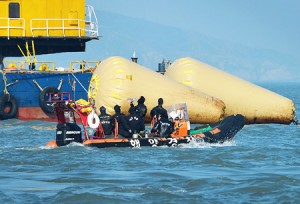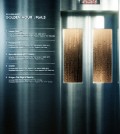- California Assembly OKs highest minimum wage in nation
- S. Korea unveils first graphic cigarette warnings
- US joins with South Korea, Japan in bid to deter North Korea
- LPGA golfer Chun In-gee finally back in action
- S. Korea won’t be top seed in final World Cup qualification round
- US men’s soccer misses 2nd straight Olympics
- US back on track in qualifying with 4-0 win over Guatemala
- High-intensity workout injuries spawn cottage industry
- CDC expands range of Zika mosquitoes into parts of Northeast
- Who knew? ‘The Walking Dead’ is helping families connect
Wasted “golden hour” doomed passengers, transcript reveals
By Nam Hyun-woo
The transcript of radio communications between the sunken ferry Sewol and a maritime operator on Jindo Island shows that crewmembers on the ill-fated ship wasted the critical early phase of the disaster, known to rescue personnel as the “golden hour.”
According to the transcript, released Sunday, the crewmembers apparently gathered at the bridge, instead of helping passengers to evacuate from their emergency positions.
“The crewmembers gathered on the bridge and cannot move. Please come quickly,” a senior mate, surnamed Kang, told a Jindo Vessel Traffic Service (VTS) center official at 9:17 a.m., Wednesday.
Most passengers were panicked in the cabins because they were improperly ordered to stay put.
“For various emergency situations, including fires, oil spills and capsizing, crewmembers are assigned to different tasks at different positions to evacuate passengers,” said Professor Lim Geung-soo of Mokpo National Maritime University.
Kang apparently failed to deliver the exact status of the ship and passengers to the operator, reiterating crewmembers could not move a step.
“Are the people on board on the life rafts or life boats?” the Jindo VTS official asked at 9:12 a.m.
“No, we’re not yet. The ship is too tilted, we can’t move,” Kang answered.
At 9:17 a.m., Kang said, “The ship is tilted more than 50 degrees to the left and it’s impossible for people to move. Crewmembers are asked to wear life jackets and stand by. … But actually it’s impossible to check if they’re wearing them or not.”
At 9:18 a.m., the Jindo VTS center asked, “How high has the water risen inside the ferry?”
The mate answered, “That cannot be checked either, because I can’t move. I can’t move even one step, left or right, on the bridge, so I’m holding the wall, barely standing.”
Waste of time
Based on the dialogue, experts believe the ship had already lost control when the ferry contacted the VTS center, and crewmembers were not attempting to evacuate passengers.
The mate was apparently panicked and repeated the same message, asking how long it would take the Coast Guard’s patrol boats to get there.
“Is the Coast Guard on its way? How long will it take to get here?” Kang said at 9:21 a.m.
The Jindo operator answered that a nearby civilian ship was approaching and the patrol boats were on their way.
As Kang repeated, “How long will it take for the Coast Guard to get here?” the Jindo VTS said it would take 10 minutes and the captain should make a decision about evacuating the passengers.
“As we don’t know the situation there, the captain should decide quickly whether to evacuate passengers,” the operator said.
Kang replied, “I’m not talking about that. If passengers evacuate, can they be rescued?”
The operator shouted “Yes. Patrol boats will be there in less than 10 minutes.”
The crewmembers’ errors in evacuating the passengers were also revealed.
At 9:23 a.m., the ship approached the Sewol and was standing by to rescue evacuating passengers.
The operator said other ships were on their way and ordered them to rescue passengers who had jumped into the sea.
Jindo VTS ordered, “It’ll take 15 minutes before patrol boats arrive. Broadcast to the passengers that they should wear life jackets.”
But Sewol replied, “It’s impossible to broadcast now.” The operator said, “Even if it’s impossible to broadcast, go out as much you can and make the passengers wear life jackets.”
Kang said, “If this ferry evacuates passengers, will you be able to rescue them?”
The operator shouted again, “At least make them wear life rings and make them escape.”
An obvious error
Professor Lim said the accident was worsened due to “the ragtag band of crewmembers.”
“Since the captain abandoned the ship first, the commanding structure collapsed. The crewmembers had also lost control,” Lim said.
He said that crewmembers made errors from the very beginning stage of sending a distress signal.
“In case of such a ‘top urgent’ situation, the ship should have sent a distress signal through channel 16 VHF,” he said.
Channel 16 VHF is used as international distress frequency. Ships usually turn on the channel all the time while underway and the coast guard units around the world monitor the channel.
Lim said, with a single click on a button, distress calls would have sent to all nearby maritime operators, the Coast Guard, other ships and even aircraft.
However, the crewmembers contacted Jeju VTS center first, which Lim said was the wrong place to call. The Jeju VTS center was some 80 kilometers from the accident site, while Jindo was some 20 kilometers away. The ship departed from Incheon and was heading to Jeju.
“If Sewol sent distress calls through the channel, quicker response from the Coast Guard would have been possible. An obvious error in initial response,” he said.
After communicating with Jeju VTS center at 8:55 a.m., the ferry contacted Jindo VTS.

















